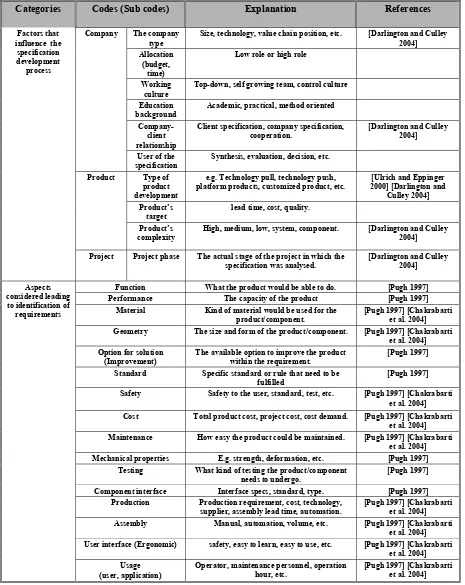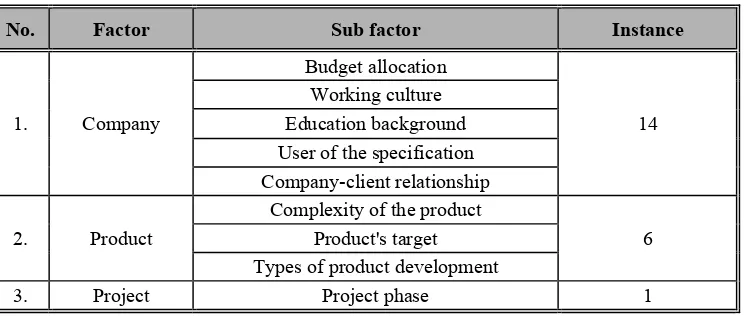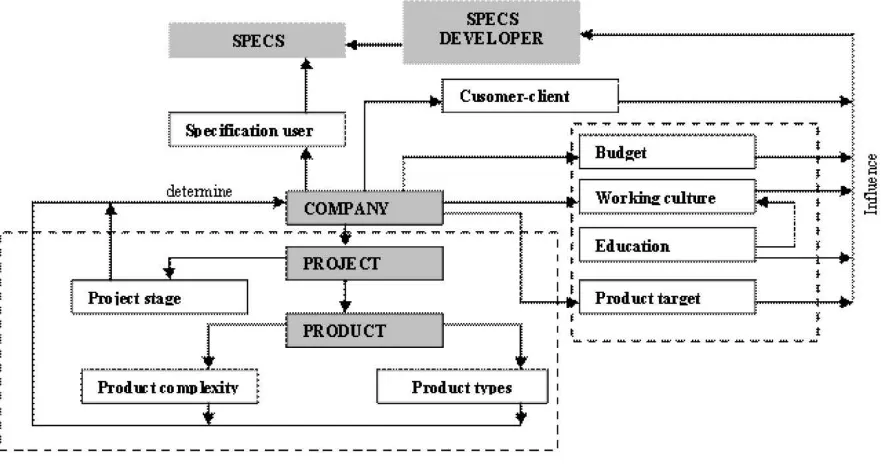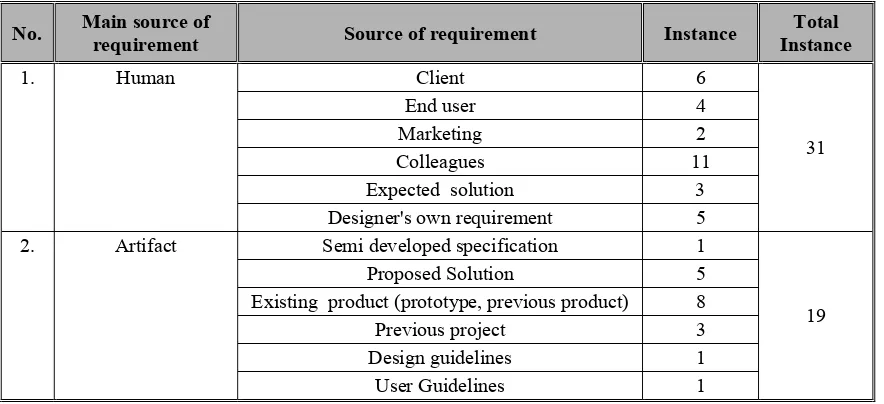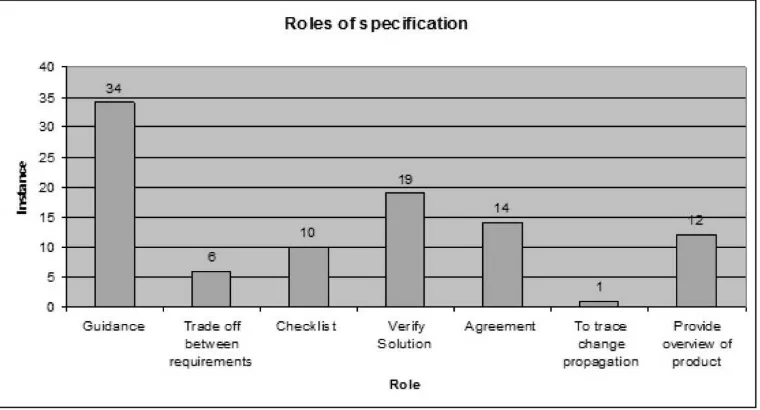INTERNATIONAL DESIGN CONFERENCE - DESIGN 2010 Dubrovnik - Croatia, May 17 - 20, 2010.
THE ROLE OF A SPECIFICATION IN THE DESIGN PROCESS: A
CASE STUDY
M. N. Sudin, S. Ahmed-Kristensen and M. M. Andreasen
Keywords: specification, design process, design tasks
1. Introduction
Design specification is a description of the desired solution to a problem [Darlington and Culley, 2002]. The role of design specification in the design process is recognised as significant. In the specification document, the description of the desired solution is described by a set of requirements. A clear description of the desired solution is important because it will increase the probability to achieve a successful design. In order to have a clear description the number of requirement statements must be sufficient to guide design engineers to proceed from the abstract to the concrete solution so as to fulfill the aim of the product. Once the problem has been identified, the criteria for selection of feasible concept are established in the form of a design specification, consisting of a list of requirements to be met by any solution to the problem. Thus the role of specification is twofold: First, to set up the solution space for design engineers to design a product and: second; to evaluate proposed solution to ensure that they fall within the acceptable boundaries.
Many product development methods e.g. [Ulrich and Eppinger, 2000] describe product development as a well-structured, sequential flow starting with a requirements specification, or design specification, and ending with a product solution. Thus establishing a design specification is essential and should be a central issue in design research [Chakrabarti, et al., 2004]. Several procedures for creating requirements for a specification are suggested in literatures e.g. [Pugh, 1997][Ulrich and Eppinger, 2000] acknowledging the benefit of having a comprehensive specification at the start of the design process. Furthermore these literatures provide some guidelines for preparation of a good specification i.e. requirements should be unambiguous, solution-independent formulation, clearly linked to customer needs, measurable (qualitative or quantitative). To ensure the specification is more practical, several authors have distinguished requirement into demand and wishes e.g. [Ulrich and Eppinger, 2000]. Yet, according to Hubka and Eder [Hubka and Eder, 1988] the contents and form of a specification are different from case to case, and are influenced by a number of factors: complexity of the factions; complete plant vs. machine component, design difficulty; new design and development vs. adaptive design, requirement for additional properties; safety, life, appearance and problem initiator or sponsor. To identify a complete set of requirements for a product at the early phase of the design process becomes essential yet impossible in reality.
Change in requirements during the design is essential for improvement or error rectification but from another point of view it may cause consequences to both time to market delay and cost increase. However both consequences rely upon the gap between the initial specification, which is developed before the design process starts to the full specification, and the specification when the design process is completed. The narrower the gap between these two specifications significantly reduces both consequences. Thus to obtain insight about the role of design specifications during the design process, a case study was carried out in a consultancy company. In this study the nature of specification development during the design process was explored and is discussed in this paper. This study is essential to provide some clue for devising supports that can help design engineers to develop a good specification.
2. Research aims and questions
The research aims to understand the nature of specification development during the design process including understanding: the development, contents of, and the roles of specification. To achieve these aims the research has three main questions as follows:
1. What influences the development of a good specification in a collaboration project (i.e. between a client and consultancy)?
2. How do the design engineers define the content of a specification? 3. How are specifications used during the design process?
3. Methodology
3.1 Research object
The study was carried out in a consultancy company. The consultancy company was selected due to their involvement in the development of different types of products (i.e. mechanical, electronic, electro-mechanical), projects (i.e. product development, design review, etc.), dealing with different type of clients and embarking at different stages of a project. These situations provide a bounty of knowledge to the design engineers in the company and their experiences were useful for this research.
3.2 Data collection method
Interviews were carried out in the consultancy company within three themes that were: ‘specification development’, ‘specification roles’ and ‘specification changes’. In total six interviews with six design engineers were carried out. Each interview was about 40 to 60 minutes and the interviews were audio recorded and transcribed. The interviews were semi-structured, the participants were asked about the topic based on the list of questions but the participants were allowed to expand the discussion. The interviews accumulate 109 years of working experience. The participants’ working experience range from 6 to 30 years and the age of participants range from 32 to 55 years old. Each participant explained about a different project that they had been involved in with the consultancy company.
3.3 Data analysis method
Table 1. Coding scheme
Categories Codes (Sub codes) Explanation References
Factors that influence the
specification development
process
Company The company type
Size, technology, value chain position, etc. [Darlington and Culley 2004]
Top-down, self growing team, control culture
Education background
Academic, practical, method oriented
Company-client relationship
Client specification, company specification, cooperation.
[Darlington and Culley 2004]
User of the specification
Synthesis, evaluation, decision, etc.
Product Type of product development
e.g. Technology pull, technology push, platform products, customized product, etc.
[Ulrich and Eppinger 2000] [Darlington and
Culley 2004] Product’s
target
lead time, cost, quality.
Product’s complexity
High, medium, low, system, component. [Darlington and Culley 2004]
Project Project phase The actual stage of the project in which the specification was analysed.
Function What the product would be able to do. [Pugh 1997] Performance The capacity of the product [Pugh 1997]
Material Kind of material would be used for the product/component.
[Pugh 1997] [Chakrabarti et al. 2004] Geometry The size and form of the product/component. [Pugh 1997] [Chakrabarti
et al. 2004] Option for solution
(Improvement)
The available option to improve the product within the requirement.
[Pugh 1997]
Standard Specific standard or rule that need to be fulfilled
[Pugh 1997]
Safety Safety to the user, standard, test, etc. [Pugh 1997] [Chakrabarti et al. 2004] Cost Total product cost, project cost, cost demand. [Pugh 1997] [Chakrabarti
et al. 2004] Maintenance How easy the product could be maintained. [Pugh 1997] [Chakrabarti
et al. 2004] Mechanical properties E.g. strength, deformation, etc. [Pugh 1997]
Testing What kind of testing the product/component needs to undergo.
[Pugh 1997]
Component interface Interface specs, standard, type. [Pugh 1997] Production Production requirement, cost, technology,
supplier, assembly lead time, automation.
[Pugh 1997] [Chakrabarti et al. 2004] Assembly Manual, automation, volume, etc. [Pugh 1997] [Chakrabarti
et al. 2004] User interface (Ergonomic) safety, easy to learn, easy to use, etc. [Pugh 1997] [Chakrabarti
et al. 2004] Usage
(user, application)
Operator, maintenance personnel, operation hour, etc.
4. Results and discussion
4.1 Initial states of specification and the development of full specification
This study aims to understand the early stage of development of specification for a collaboration (i.e. between client and consultancy) project. The full specification development mostly reflects the state of the client’s specification. Thus to achieve this aim the study investigates the states of specification received by the consultancy company from their clients at the beginning of the collaboration project. The study found that the consultancy company received the specification from their clients in three different states that were:
Verbal specification received.
Semi-developed; i.e. only partially written down and finished.
Full specification document.
The consultancy company received a semi-developed specification from their client at the beginning of the collaboration project, for the majority of cases as shown in Table 2
Table 2. Types of client's specification
Type of Specification Verbal Semi-developed Full specification
Instance 2 11 2
The full specification needs to be developed in the cases where the clients approach the consultancy company with none (verbal) or semi developed specification. The study also investigated who develops the full specification for a collaboration project. It was found that the full specification developers for a collaboration project were:
Client of the consultancy company
The consultancy company
Both client and consultancy together
The result of the study reveals that the consultancy company was mainly responsible for developing the full specification for a project and the majority of the full specifications were developed by the design engineer in the consultancy company as shown in Table 3. The study also found that the client did provide full specification to the consultancy company for cases where the consultancy company has to solve the problem of an existing product without changing the specification i.e. meeting the specific requirement in the specification. In this case the consultancy company received the full specification of the product together with the encountered problem. There were also cases where the full specification was developed by the collaboration of both the consultancy company and client. The result highlighted that design engineers need to spend a large amount of their time to develop the specification during early product development process. The design engineers in the consultancy company should bear in their mind that developing the full specification is one of their tasks.
Table 3. Full specification developer
Specification developer Client Consultancy Both
Design Engineer Design team
Instance 2 11 4 5
Table 4. Execution of the specification design
Specification design After the design process Before the design process
Instance 1 16
The importance to develop specification in early design process was stated in several literatures e.g. [Pugh, 1997]. This result confirmed that industrial practice was in line to design methodology literature. The result of the study has shown that the major role of specification was to control the design engineers to find feasible solutions for a problem. This result was strengthen by several design methodology literatures e.g.[Ulrich and Eppinger, 2000]. The underlying assumption of all literatures, is that it was meaningful to interpret an understanding of the potential customers’ need (customer focus) and perception of value into a set of specification statements in the form of a specification before actually search for design solution. Therefore further research to support design engineers to identify all the necessary requirements at the beginning of the design process become essential i.e. the requirements that helps them to execute the design tasks.
4.2 Factors influencing the development of a specification for a project
The study also investigates the factors that influence the development of specification for a project. The study found three main factors that were:
Company: The company type, budget allocation, working culture, education background, the user of the specification and company-client relationship.
Product: Complexity of the product, product’s target and types of product development.
Project: Project phase.
The company including: budget allocation provided by the company for a project, working culture in the company, education background of the design engineers, user of the specification and company-client relationship (i.e. business to business) was very much influencing the development of the specification as shown in Table 5. Similar results of factors influencing design requirement were also found in another study i.e. company type, stakeholders relationship, product type, product complexity, [Darlington and Culley, 2004]. They also discovered some other factors i.e. maturity of initial design requirement, design activity type, design requirement capture methodology, contract formality, level of design expertise and level of design requirement development expertise. The need for information to develop a specification and the influence of education background of design engineers to the company also was also identified as factor in a separate study [Macdonald and William, 1993].
Table 5. Factors that influence to the full specification development process
No. Factor Sub factor Instance
1. Company
Budget allocation
14 Working culture
Education background User of the specification Company-client relationship
2. Product
Complexity of the product
6 Product's target
Types of product development
3. Project Project phase 1
the company. Despite that the allocated budget for a project and the product target i.e. when it should be release to the market influencing specification developer in the specification development process i.e. how much time they have before the deadline. Meanwhile the user of the specification and company-client relationship influencing specification development, which was considered by specification developer when they begin to develop a specification.
Figure 1. Relationship between factors, sub factors influencing in specification design
4.3 Identification of sources and aspects of requirements
The study also investigates how a specification is developed, through understanding the aspects considered which lead to the identification of requirements which form part of the specific action. The study found the requirements in the specification evolves during the design process. Designer engineers were found to consider seventeen aspects of the product lifecycle leading to identification of requirements as shown in Figure 2.
Aspects considered led to indentification of requirement
The majority of the requirements were identified when the design engineers considered the user including; usage (i.e. application, user), user interface (ergonomic) and safety. Similar aspects and other aspects that were considered leading to identification of requirements was found in the protocol study by Chakrabarti et al. [Chakrabarti et al. 2004]. The study also observed two approaches of requirements search that occurred repetitively during the design process these were:
Aspect to source
Source to aspect.
These approaches occurred in the problem domain e.g. the specification developers begin by considering safety aspect then they identify end user as the source. Furthermore they start with end user and start to consider ergonomic aspect. Figure 3 shows the approach of requirements search during the design process for a project.
Figure 3. Approach of requirements search for a project
The study investigated the sources of requirements during the design process. The result shows that twelve sources of requirement that the design engineers were referred to can be classified into two major sources that were:
Human: Client, end user, market analysis, colleagues, expected solution, designer’s own requirement.
Artifact: Semi developed specification, proposed solution, existing product, previous project, design guideline, user guidelines.
Table 6. Sources of requirements during the design process
No. Main source of
requirement Source of requirement Instance
Total Instance
1. Human Client 6
31
End user 4
Marketing 2 Colleagues 11
Expected solution 3
Designer's own requirement 5
2. Artifact Semi developed specification 1
19
Proposed Solution 5
Existing product (prototype, previous product) 8
Previous project 3
Design guidelines 1
User Guidelines 1
trade journal, technical manual)[Wootton, et al., 1997]. In another study [Romer, et al., 2001] found task clarification was performed by discussion with colleagues (80%), customer (60%) and by document analysis. Furthermore, market analysis, analysis of legal defaults and consulting other departments involved in product development (e.g., sales department, marketing, and manufacturing) were also reported. This result has highlighted the importance of communication and knowledge sharing between design engineers with other stakeholders in order to develop a good specification. Furthermore by considering all aspects and sources (origin) of requirements continually along the design process, may result in a reduction in the number of changes in requirement. However attention should be given to ensure that new requirements that were identified at least appear in the right stage of the design process i.e. requirement about function appear at conceptual design stage. This is important because if the requirement is needed in the conceptual design stage emerges at the embodiment stage then the design engineers may need to do more design iteration.
4.4 Roles of specification
As the role of specification during the design process influences it’s development, this also formed part of the investigation. The specification plays a vital role in the product development process and was found to have various roles including :
Guidance to designers
Identify trade-off between requirements
A checklist e.g. during milestone meeting
Evaluation of solutions to select the one that is most suited to the specification
An agreement within the design team, and as an agreement with the client e.g. company-supplier agreement on fulfilling the design task.
To trace the likelihood of change propagation.
Product overview
The specification design should reflect how the specification is used during the product development process. Based on this study the design engineers used the specification for: guidance to execute the design tasks, to identify conflict between requirements so they can do requirements trade-off, as a checklist e.g. during milestones meeting, to verify solution, agreement within design team or with client, to trace change propagation likelihood and serve as product overview before they proceed with their design tasks. However, the majority of specifications were used as a mean to guide design engineers to execute the design tasks into advance stage. The similar usages of specification were also found in another study [Nijhuis and Roozenburg, 1997] where it was used as: a guidance, verify solution and an agreement. This result highlighted some important notes; firstly, the developers of specification should be aware of the roles of specification as it being designed to ensure that it is really useful and of benefit to design engineers to execute their design tasks. Secondly, further research to characterize specification based on it usages is essential as the specification has multiple roles in the product development activities.
5. Conclusion
The study has been carried out by interviewing six design engineers in a consultancy company. The themes of interviews were about the creation of specification and roles of specification during the design process. The study investigated consultants viewpoints about specification development in the business to business context. Since the interviews were open ended and the participants were allowed to expand the discussion, the study also uncovered a few additional aspects which were helpful to understand the topic of the study.
The results of the case study assist in obtaining an insight into the development of specification in the customer-client context from the consultant viewpoints. It was clear that a specification is a central element in the product development process as it provides vital information for design engineers to execute the design tasks i.e. for concept generation and solution evaluation. However due to it multiple roles in the product development environment as were found from this case study, the specification could be developed in response to it usage i.e. in what context it will be used. For example, as a guidance to design engineers to execute the design tasks the requirements in this specification should be difference to the requirements in the specification that will be used for tendering in the customer-supplier context even for the same project. Providing specific type of specification to the right application helps to avoid design engineers with being overwhelmed with information and leading to the specification not being used during the design process. Thus in the design process methodology, support such as a method to identify requirements that the design engineers need to execute their design tasks maybe essential.
Acknowledgement
I would like to thank Institute of Product Development (IPU) for participation in the studies, UTeM and MOHE for the funding.
References
Andersson, F., “The dynamic of requirements and product concept management: a product modelling approach”, PhD Thesis, Chalmers University of Technology, Goteborg, Sweden, 2003.
Chakrabarti, A., Morgenstern, S. and Knaab, H., “Identification and application of requirements and their impact on the design process: a protocol study”, Research in Engineering Design, Vo. 15, pp22-3,. 2004. Darlington, M.J. and Culley, S.J. “A model of factors influencing the design requirement”, Design Studies, Vol. 25, pp329-350, 2004.
Hansen, C. T. and Andreasen, M.M., “Specifications in early conceptual design work”, ICED 07, Paris, August 28-31.
Hubka, V. and Eder, W.E., “Theory of technical system: a total concept theory for engineering design”, Springer-Verlag, Berlin, Germany,1988.
Pugh, S., “Total design: integrated methods for successful product engineering”, Addison-Wesley Longman Ltd., Essex, UK. 1997.
Romer, A., WeiBhahn, G., Hacker, W., Pache, M. And Lindemann, U. “Effort-saving product representations in design-results of a questionnaire survey”, Design Studies, Vol. 22, pp473-491, 2001.
Ulrich, K.T. and Eppinger, S. D., “Product design and development, 3rd Adition”, McGraw Hil Inc., NY. USA.
2000.
Wootton, A.B., Cooper, R. and Bruce, M., “Requirements capture: where the front end begins?” ICED 97, Tampere, Finland, August 19-21.
Mohd Nizam Bin Sudin
Technical University of Denmark Department of Management Engineering 2800 Kgs. Lyngby, Denmark
